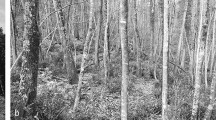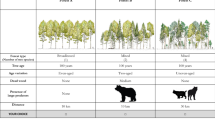Abstract
The ancestral tradition of gathering nontimber products in the Andean forests of Patagonia seems to be on the verge of disappearing. Edible wild plant knowledge and differential patterns of use have been compared in two populations of different economic and cultural backgrounds—a small rural Mapuche community (Rams), and an outlying population (El Frutillar). The first is located in an herbaceous steppe far from the nearest Andean forest while the second is located outside the town of Bariloche, near the forests of Nahuel Huapi National Park. Semistructured interviews and related ecological variables were compared in both communities. In the past, both communities utilized nontimber forest products from the Andean Temperate forests. However, today, cost and benefit trade-offs appear to affect when and what edible resources are collected. The people from El Frutillar gather fewer wild plants in spite of the high plant abundance and the notorious food scarcity they suffer. The Mapuche people use more nutritious resources, more native species, spend longer traveling to the gathering site, and longer handling time preparing edible plants.
Similar content being viewed by others
References
Aagesen, D. L. (1998). Indigenous resource rights and conservation of the monkey-puzzle tree (Araucana araucana, Araucariaceae):Acase study from southern Chile. Economic Botany 52(2): 146–160.
Abalerón, C. (1990). Unaaproximación objetiva y subjetiva a la calidad de vida de la población de algunos barrios con características de mayor o menor marginalidad, Fundación Bariloche, Bariloche.
Arrúe, W., and Kalinsky, B. (1991). De “La Medica” y el Terapeuta, La Gestión Intercultural de la Salud en el Sur de la Provincia del Neuquón. Centro Editor de América Latina S.A., Bs. As, Argentina.
Begossi, A. (1992). The use of optimal foraging theory in the understanding of fishing strategies: A Case from Sepetiba Bay (Río de Janeiro State, Brazil). Human Ecology 20(4): 463–475.
Begossi, A., and Richerson, P. J. (1993). Biodiversity, family income and ecological niche: A study on the consumption of animal foods on Bzios Island (Brazil). Ecology of Food and Nutrition 30: 51–61.
Boesch, C., and Tomasello, M. (1998). Chimpanzee and human cultures. Current Anthropology 39(5): 591–614.
Cabrera, A. L. (1976). Regiones Fitogeográ;ficas Argentinas, Fascículo 1. Enciclopedia Argentina de la Agricultura y Jardinería, Tomo II, Editorial Acme S.A.C.I, Buenos Aires.
Cabrera, A. L., and Willink, A. (1980). Biogeografí;a de América Latina, Monografía no. 13. Sec. General de la Organización de los Estados Americanos, Washington, DC.
Ceballos, Z. N., and Gassiot, R. S. (1996). La importancia económica de la semilla de Araucaria araucana para la unidad familiar pehuenche. Cuadernos Agroforestales 1. Desarrollo Agroforestal y Comunidad Campesina (Salta) 4(20): 46–51.
Citarella, L. (1995). Medicinas y Culturas en La Araucanía, Trafkin, Programa de atención primaria en salud, Cooperación Italiana, Ediciones Sudamericana, Chile.
Conover, W. J. (1971). Practical Nonparametric Statistics, Wiley, New York.
Correa, M. N. (ed.). (1969, 1971, 1978, 1984, 1988, 1998). Flora Patagónica, Partes 1, 2, 3, 4, 5, y 7, Colección Científica del Instituto Nacional de Tecnología Agropecuaria, Bs. As., Argentina.
Díaz-Betancourt, Ghermandi, M. L., Ladio, A., López-Moreno, I. R., Raffaele, E., and Rapoport, E. H. (1999). Weeds as a source for human consumption. A comparison between tropical and temperate Latin America. Revista Biología Tropical 47(3): 329–338.
Duke, J. A. (1985). Handbook of Medicinal Herbs, CRC Press, Boca Ratón, FL.
Elias, T. S., and Dykeman, P. A. (1990). Edible wild plants. A North American Field Guide, Sterling, New York.
Feinsinger, P. (in press). Scientific Inquiry As a Tool in Protected Area Management in Latin America, the Caribbean, and Elsewhere, Primers Series, The Nature Conservancy, Latin American and Caribbean Division.
Food and Agriculture Organization of the United Nations. (1988). Traditional food plants, Paper No. 42, FAO Food and Nutrition, Rome.
Gispert, M., and Gómez Campos, A. (1986). Plantas medicinales silvestres: el proceso de adquisición, transmisión y colectivización del conocimiento vegetal. Biótica 11(2): 113–125. 380 Ladio and Lozada
Godoy, Brokaw, R. N., and Wilkie, D. (1995). The effect of income on the extraction of nontimber tropical forest products: Model, hypotheses, and preliminary findings from the Sumu Indians of Nicaragua. Human Ecology 23(1): 29–52.
Gragson, T. L. (1993). Human foraging in lowland South America: Patterns and process of resource procurement. Research in Economic Anthropology 14: 107–138.
Hughes, R. N. (1993). Basic optimal diet theory. In Hughes, R. N. (ed.), Diet Selection. An Interdisciplinary Approach to Foraging Behavior, Blackwell Scientific Publications–Cambridge University Press, Oxford, Cambridge, pp. 1–9.
Keegan, W. F. (1986). The optimal foraging analysis of horticultural production. American Anthropologist 88(1): 92–105.
Laferrière, J. E. (1995). A Dynamic nonlinear optimization study of mountain Pima subsistence technology. Human Ecology 23(1): 1–27.
Ladio, A., and Lozada, M. (2000). Edible wild plant use in a Mapuche community of Northwestern Patagonia. Human Ecology 28(1): 53–71.
Marticorena, C., and Quezada, M. (1985). Flora vascular de Chile. Guayana 42(1/2): 1–157.
Martínez-Crovetto, R. (1980). Apuntes sobre la vegetación de los alrededores del lago Cholila. Publicació;n Técnica Nro. 1. Universidad Nacional del Nordeste, Facultad de Ciencias Agrarias, pp. 1–22.
Mace, R., and Pagel, M. (1997). Tips, branches, and nodes: Seeking adaptation through comparative studies. In Betzig, L. (ed.), Human Nature. A Critical reader, Oxford University Press, New York, pp. 197–310.
Mösbach, E. W. (1992). Botánica Indígena de Chile, Museo Chileno de Arte Precolombino, Fundación Andes, Ediciones Andrés Bello, Santiago.
Müeller-Dombois, D., and Ellemberg, H. (1974). Aims and Methods of Vegetation Ecology, Wiley, New York.
Mulder, M. B. (1991). Human behavioral ecology. In Brebs, J. K., and Davies, N. B. (eds.), Behavioral Ecology.An Evolutionary Approach, Blackwell Scientific Publications, Oxford, pp. 69–97.
Ollason, J. G. (1987). Foraging theory and design. In Kamil, A. C., Krebs, J., and Pulliam, H. R. (eds.), Foraging Behavior, Plenum New York, pp. 549–563.
Perry, G., and Pianka, E. R. (1997). Animal foraging: Past, present and future. Trends in Ecology and Evolution 12(9): 360–364.
Pimentel, D., McNair, M., Buck, L., Pimentel, M., and Kamil, J. (1997). The value of forest to world food security. Human Ecology 25(1): 91–115.
Roquero, M. J. (1968). La vegetación del Parque Nacional Laguna Blanca. Anales de Parques Nacionales Tomo XI: 129–207.
Schmidt-Hebbel, H., and Pennachiotti Monti, I. (1985). Tabla de Composición Química de Alimentos Chilenos, Facultad Ciencias Químicas y Farmacéuticas, Universidad de Chile, Editorial Universitaria, Santiago.
Smith, E. A. (1983). Anthropological Applications of Optimal Foraging Theory: A Critical Review. Current Anthropology 24(5): 625–651.
Wickramasinghe, A., Pérez, M. R., and Blockhus, J.M. (1996). Nontimber forest product gathering in Ritigala Forest (Sri Lanka): Household strategies and community differentiation. Human Ecology 24(4): 493–519.
Author information
Authors and Affiliations
Rights and permissions
About this article
Cite this article
Ladio, A.H., Lozada, M. Nontimber Forest Product Use in Two Human Populations from Northwest Patagonia: A Quantitative Approach. Human Ecology 29, 367–380 (2001). https://doi.org/10.1023/A:1013199103440
Issue Date:
DOI: https://doi.org/10.1023/A:1013199103440




